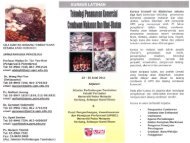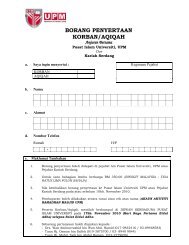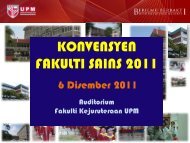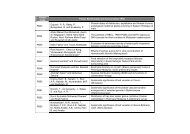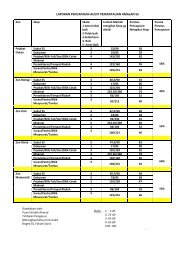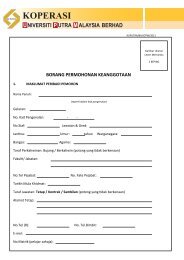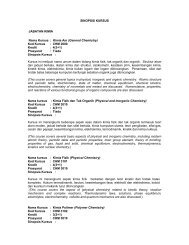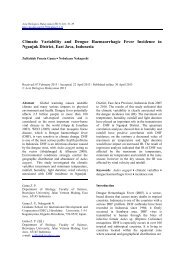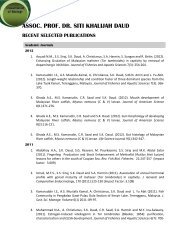Programme Book - UPM - Universiti Putra Malaysia
Programme Book - UPM - Universiti Putra Malaysia
Programme Book - UPM - Universiti Putra Malaysia
You also want an ePaper? Increase the reach of your titles
YUMPU automatically turns print PDFs into web optimized ePapers that Google loves.
P48 OXIDATION OF BENZYL ALCOHOL TOBENZALDEHYDE USING Au-Pd SUPPORTED ON TiO 2 CATALYSTN.R. Mohd Jumat, M.I. Saiman*Department of Chemistry, Faculty of Science, <strong>Universiti</strong> <strong>Putra</strong> <strong>Malaysia</strong>, 43400 <strong>UPM</strong>Serdang, Selangor, <strong>Malaysia</strong>Corresponding author: izham@science.upm.edu.myOver recent years, the use of gold catalyst has been proven successful in several fieldof research. One of the most interesting finding is that this catalyst is reactive towardsoxidation reaction of alcohols to aldehydes. Commercially, oxidations of alcohols aredone by using dichromate or permanganate as the oxidant together with solventswhich is not environmental friendly due to its toxicity as well as not economical. Inthis study, the focus is on the catalytic activity and the selectivity of titania-supportedgold catalyst upon the production of benzaldehyde from benzyl alcohol at mildcondition (80-100°C) without using any solvent for environmental concern. To provethat gold catalyst is a remarkable oxidation catalyst, some evaluation has been madethroughout this study involving the effect on the reusability, reaction time, the uses ofdifferent masses, metal loading and also the effect of catalytic activity with differentpreparation methods. Gold-palladium supported on titania (Au-Pd/TiO 2 ) catalystswere prepared using two preparation methods namely sol immobilisation andimpregnation method. Meanwhile, for the catalyst testing, two types of analysis wereemployed; gas chromatography (GC) and gas chromatography mass spectrometry(GC-MS) to detect the reactant consumption and products obtained from the catalyticreaction. For physical analysis of catalysts, X-Ray diffraction (XRD) and BrunauerEmmet Teller (BET) surface area analysis were used. Throughout this investigation, itis obvious that the catalyst prepared by sol immobilisation method have shown betterconversion which is at 53.9% with highest selectivity of benzaldehyde at 92.9%;compared to the catalyst prepared by impregnation method which only have 23.3%conversion. The conversion and selectivity toward the products was found to bedependent on the metal loading and its catalytic system either it is bimetallic ormonometallic. Bimetallic Au-Pd catalyst has been proven to have higher conversionand selectivity than monometallic Au or Pd catalysts. Moreover this study has shownthat, by increasing the mass of catalyst used in the reaction, the conversion of thebenzyl alcohol to benzaldehyde increased by 5% from 53.9% (0.2g catalyst) to 58.9%(0.3g catalyst). Prolonging the reaction has linear effect to the rate of conversionwhere it reached up to 78.9% after 24 hours. This whole study has successfullyachieved its main objectives which are to perform the reaction at mild condition withaddition of less harmful oxidant by utilizing the tremendously interesting catalystwhich is gold-palladium supported on titania.63 |16 th Industrial Chemistry Seminar: Chemistry- A Passport to a Brighter Future




